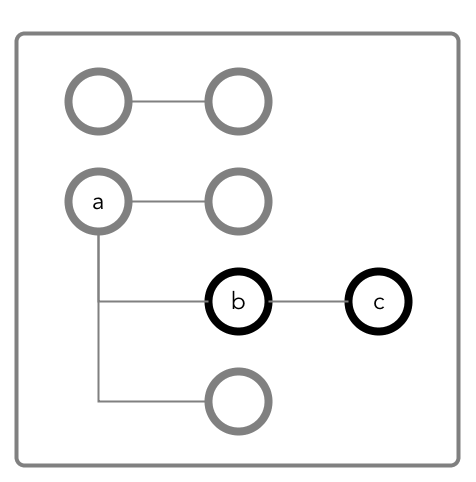Permissions on Non-default Column Families
If
a JSON document field is not in the MapR Database JSON default column
family, you must have readperm and writeperm permissions to
perform read and write operations on the field. You either receive the permissions from
the column family, inherit them from the field's parent field, or have the permissions from an
explicit grant on the field.
The following diagram shows a JSON document where fields b and
c are in a column family cf1 that is defined at field
b with the path a.b.

Granting Read and Write Permissions on Field c
To perform both read and write operations on field c, when it is in column
family cf1, you must have both readperm and
writeperm access on field c:
- If you have
readpermandwritepermpermissions oncf1, then you have access to fieldc. - If you have
readpermandwritepermpermissions on fieldb, then you have access to fieldc. You do not need any further permissions. Fieldcinherits yourreadpermandwritepermpermissions from fieldb. - If you have
readpermandwritepermpermissions oncf1but either fieldaorbdenied you permissions:- You must have
traversepermpermission granted to you on the field that denied you access (fieldaorb). - You must have
readpermandwritepermpermissions explicitly granted to you on fieldc.
- You must have
- If you do not have
readpermandwritepermpermissions oncf1:- You must have
traversepermpermission granted to you on eithercf1or field b. - You must have
readpermandwritepermpermissions explicitly granted to you on fieldc.
- You must have
The following are examples of commands that grant these permissions:
/opt/mapr/bin/maprcli table cf colperm set
-path <path to JSON table >
-cfname cf1
-name a.b
-traverseperm u:<user ID> | <existing ACE for this field> /opt/mapr/bin/maprcli table cf colperm set
-path <path to JSON table >
-cfname cf1
-name a.b.c
-readperm u:<user ID> | <existing ACE for this field>
-writeperm u:<user ID> | <existing ACE for this field>/opt/mapr/bin/maprcli table cf edit
-path <path to JSON table >
-cfname cf1
-traverseperm u:<user ID> | <existing ACE for this field> /opt/mapr/bin/maprcli table cf colperm set
-path <path to JSON table >
-cfname cf1
-name a.b.c
-readperm u:<user ID> | <existing ACE for this field>
-writeperm u:<user ID> | <existing ACE for this field> Granting Read or Write Permission on Field c
To perform either read or write operations on field c, when it is in
column family cf1, you must have either readperm or
writeperm access on field c:
- If you have the same permission (
readpermorwriteperm) oncf1, then you have access to fieldc. - If you have the same permission (
readpermorwriteperm) on fieldb, then you have access to fieldc. You do not need any further permissions. Fieldcinherits yourreadpermorwritepermpermission from fieldb. - If you have the same permission (
readpermorwriteperm) oncf1but either fieldaorbdenied you permission:- You must have
traversepermpermission granted to you on the field that denied you access (fieldaorb). - You must have
readpermorwritepermpermission explicitly granted to you on fieldc.
- You must have
- If you do not have the same permission (
readpermorwriteperm) oncf1:- You must have the
traversepermpermission granted to you on eithercf1or fieldb. - You must have
readpermorwritepermpermission explicitly granted to you on fieldc.
- You must have the
The following example grants traverseperm permission:
/opt/mapr/bin/maprcli table cf colperm set
-path <path to JSON table>
-cfname cf1
-name a.b
-traverseperm u:<user ID> | <existing ACE for this field> The following example grants readperm permission:
/opt/mapr/bin/maprcli table cf colperm set
-path <path to JSON table>
-cfname cf1
-name a.b.c
-readperm u:<user ID> | <existing ACE for this field>